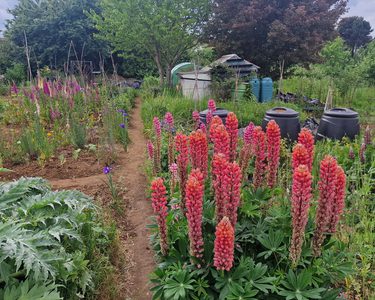Allotment innovation making plots more accessible and biodiverse

A new national survey has revealed how local councils are successfully adapting to the intense and sustained demand for allotments by creating smaller and more manageable plots, whilst embedding biodiversity and accessibility into their services.
The ‘State of the Market 2025’ report from The Association for Public Service Excellence (APSE) found 76% of local authorities have reduced the size of standard plots to create smaller options (12% increase since 2022) in a bid to manage lengthy waiting lists.
The report also highlights a growing commitment to environmental sustainability, with 80% of councils setting aside areas for wildlife on allotment sites. Councils promoting pollinator-friendly planting has seen a 15% rise since 2023.
Our head of organic horticulture, Chris Collins, said: “For me the allotment is a shared space: I share it with the birds, the pollinators and even a selection of mammals. They all contribute to the both the balance of the plot but also my appreciation of nature.
“It’s great news that more councils are recognising allotments are important components when it comes to supporting our wildlife, particularly in urban areas. And it does not mean compromising the growing of food, the two are capable of sitting side-by-side in perfect harmony.”
Waiting lists plateau 🔗
Despite the high demand for allotments - with 63% of councils reporting average waiting times of more than 18 months - the survey indicates this critical pressure may be starting to plateau. The proportion of authorities with more than 1,000 people on their waiting list has remained steady, suggesting council strategies to increase supply are beginning to have an impact.
Councils are also making strides in ensuring their services are inclusive. Over half (57%) now make specific provisions for people with disabilities, such as providing raised beds and accessible pathways. 60% of authorities also continue to offer concessionary rents to support vulnerable groups, including pensioners and those on low incomes.
While financial pressures remain, with 63% of councils still subsidising their allotment service, the trend is moving towards cost neutrality. Many are carefully balancing necessary rent increases with the need to keep plots affordable, ensuring they remain a valuable community resource.
Other key findings from the APSE 2025 report include:
- Strategic importance: More than half of all local authorities (57%) now include specific policies for the protection and provision of allotments in their Local Plans, recognising their strategic value.
- Meeting demand: 37% of authorities now manage more than 30 allotment sites, an increase rise from 27% in 2019, demonstrating a concerted effort to expand provision.
- Fair access: For the first time, a majority of councils (55%) now restrict plot ownership to one per person or household to ensure fairer access for all.
The full report provides a comprehensive analysis of allotment management, costs, waiting lists, and strategies across the UK.
For more tips on finding, managing and growing on allotment plots head to our Beginner Guide.